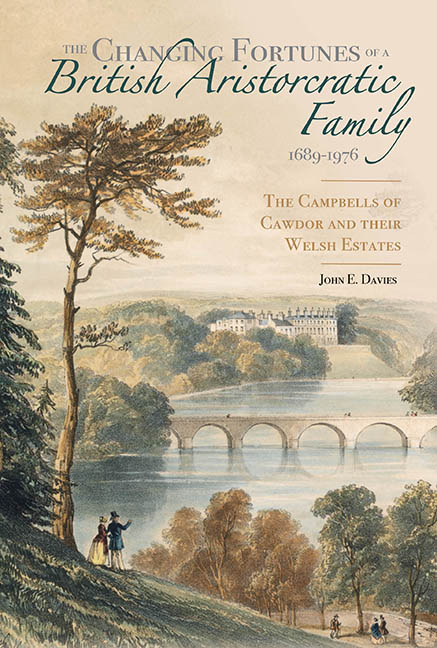 The Changing Fortunes of a British Aristocratic Family, 1689–1976
The Changing Fortunes of a British Aristocratic Family, 1689–1976 Book contents
- Frontmatter
- Contents
- List of Illustrations
- Acknowledgements
- List of Abbreviations
- Pedigree
- Introduction
- 1 Cawdor and Campbell
- 2 Estate Administration
- 3 The Agricultural Estate: The Cawdors as Farmers and Landlords
- 4 The Cawdors as Industrial Landowners
- 5 The Cawdors in the Community: Church and Education
- 6 The Mêlée of Local Governance
- 7 The Cawdors in Politics: Interest Building, Consolidation and Decline
- 8 Private and Exclusive Lives
- 9 The End of the Welsh Estates
- Conclusion
- Bibliography
- Index
4 - The Cawdors as Industrial Landowners
Published online by Cambridge University Press: 21 March 2020
- Frontmatter
- Contents
- List of Illustrations
- Acknowledgements
- List of Abbreviations
- Pedigree
- Introduction
- 1 Cawdor and Campbell
- 2 Estate Administration
- 3 The Agricultural Estate: The Cawdors as Farmers and Landlords
- 4 The Cawdors as Industrial Landowners
- 5 The Cawdors in the Community: Church and Education
- 6 The Mêlée of Local Governance
- 7 The Cawdors in Politics: Interest Building, Consolidation and Decline
- 8 Private and Exclusive Lives
- 9 The End of the Welsh Estates
- Conclusion
- Bibliography
- Index
Summary
As was frequently the case with other British landowners, the Cawdors not only pursued their agricultural interests with the aim of receiving a good financial return on their efforts, but exploited wherever possible any mineral resources upon their estates. Within the more open society that prevailed in Britain, landowners did not lose status through participating in commercial and industrial enterprise, and, with their estates frequently encumbered by debt, they were eager to secure the additional revenues that would be yielded from industrial undertakings. The Stackpole estate was almost entirely agricultural. However, when the Campbells purchased the Ystradffin estate, in the hilly north-east of Carmarthenshire, in 1717, they acquired the potential of reaping great rewards from the lead mines situated within that estate.
Sir Henry Lort purchased the Ystradffin estate from a Gregory Morris and others, in October 1629, for the large sum of £4,420. However, if mining was being undertaken in the early seventeenth century it must have been on a very small scale and only at the end of that century does evidence of mining begin to emerge. In John Woodward's An Attempt Towards a Natural History of the fossils of England, ‘a mine of my Lady Cambell's near Ystradphene, Wales’ is catalogued, the Lady Cambell being Elizabeth Campbell (nee Lort), the joint heiress of Stackpole Court. Fieldwork for Woodward's book was undertaken in c.1706 by his erstwhile friend and fellow geologist, John Hutchinson, who refers to the ‘rubble of the lead-mine’, implying it had been worked for some time.
The first three decades of the eighteenth century were poor ones for lead mining and other risk-taking economic activities generally. Lead mining in Ceredigion had become stagnant after the Mine Adventurers and Sir Humphrey Mackworth11 were found guilty of ‘many notorious and scandalous Frauds’. And in general, ‘the whole of the industry in central Wales seems to have been in a state of depression from 1710 until the late 1730s’. The financial fiasco of the South Sea Bubble would have assisted in that depression – investors in a risky industry like mining speculation would have been few.
- Type
- Chapter
- Information
- The Changing Fortunes of a British Aristocratic Family, 1689–1976The Campbells of Cawdor and their Welsh Estates, pp. 99 - 136Publisher: Boydell & BrewerPrint publication year: 2020
